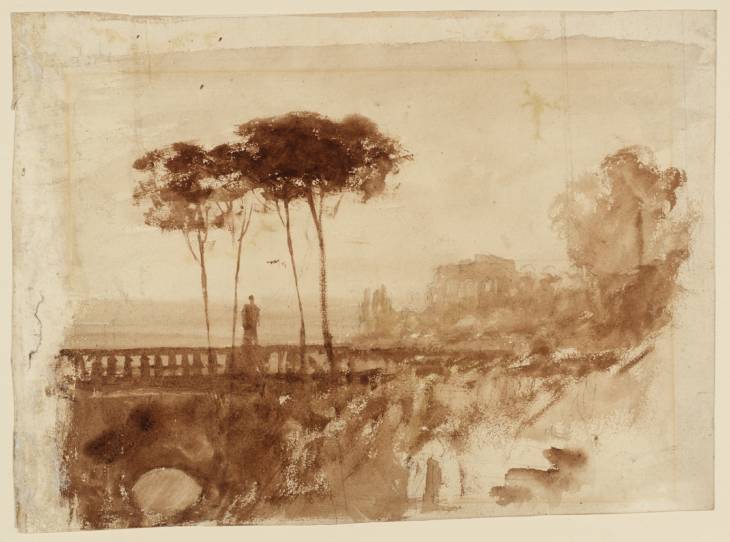Joseph Mallord William Turner An Italianate Terrace or Bridge with a Statue c.1815-19
Joseph Mallord William Turner,
An Italianate Terrace or Bridge with a Statue
c.1815-19
Joseph Mallord William Turner 1775–1851
An Italianate Terrace or Bridge with a Statue circa 1815–19
D40045
Turner Bequest CXVIII h
Turner Bequest CXVIII h
Pencil and watercolour on off-white wove paper, 232 x 315 mm
Blind-stamped with Turner Bequest monogram bottom centre
Blind-stamped with Turner Bequest monogram bottom centre
Accepted by the nation as part of the Turner Bequest 1856
Exhibition history
2000
Pure as Italian Air: Turner and Claude Lorrain, Clore Gallery, Tate Britain, London, November 2000–April 2001 (no catalogue).
2002
Turner et le Lorrain, Musée des beaux-arts, Nancy, December 2002–March 2003 (25, reproduced in colour, as ‘An Italianate Terrace with a Statue’, circa 1815–20, but see discussion below).
References
1911
Liber Studiorum: J.M.W. Turner: Miniature Edition Containing Reproductions (I.) from First Published State of the Seventy-One Published Plates, and (II.) of the Original Drawings for, or Engraver’s Proofs of, All the Unpublished Plates as the Artist Left Them, London and Glasgow 1911, reproduced p.126 no.101?? [sic], as ‘Bridge with Statue’.
1996
Gillian Forrester, Turner’s ‘Drawing Book’: The Liber Studiorum, exhibition catalogue, Tate Gallery, London 1996, pp.16, 25 note 92.
2002
Ian Warrell, Blandine Chavanne and Michael Kitson, Turner et le Lorrain, exhibition catalogue, Musée des beaux-arts, Nancy 2002, p.189.
This unfinished drawing has traditionally been categorised as an unengraved idea for the Liber Studiorum. It appears to show an imaginary scene and, as Ian Warrell has suggested,1 it was probably made before Turner’s first visit to Italy in 1819, though informed by his knowledge of Italy through paintings and prints by other artists. The silhouetted trees are reminiscent of those in the published subjects The Temple of Minerva Medica and Scene in the Campagna (for drawings see Tate D08128, D08141; Turner Bequest CXVII A, N); both were in Turner’s ‘EP’ category, generally thought to signify ‘Elevated Pastoral’ and owing much to the work of Claude Lorrain (see general Liber introduction). The distant classical buildings or ruins are also similar to those in engraved ‘EP’ compositions. There is another view of a garden with a balustrade among the unengraved Liber-type drawings, traditionally said to show Mâcon, France (Tate D08179; Vaughan Bequest CXVIII Y).
The work once formed a single sheet with Tate D08187 (Turner Bequest CXVIII g);2 the top edges of the respective compositions met, and were separated by freehand cutting. The border of the wash laid in for the sky on the other ‘half’ is visible along the uneven, matching top edge of the present work. A pencil line extending from about half-way up the right-hand edge of the sheet continues on the other drawing; thin, vertical stains about a quarter of the way in from each edge also continue onto the other sheet. These must pre-date their separation, either by Turner, or early on following their arrival at the National Gallery as part of the Turner Bequest, as the other work was allocated a number and title. However, the present ‘half’ was somehow overlooked by Finberg in his 1909 Inventory,3 its number ‘CXVIII h’ being a subsequent addendum. It appears to have been mounted by 1911, as the cropping of the Miniature Edition reproduction corresponds to yellowish staining on the sheet from a previous mount. However (unlike D08187, the last work recorded in the Liber sections of Finberg’s Inventory), it is not on the typescript list of exhibits for the comprehensive Liber exhibition held at the Tate Gallery and the Whitworth Institute, Manchester, between 1921 and 1923.4
It is one of five unfinished compositions which were grouped at the end of the 1911 Miniature Edition of reproductions of the Liber, as suggestions (probably by W.G. Rawlinson, who gave ‘generous help and advice all through’5) for a ‘no.101??’ to bring the series up to the frontispiece plus a full twenty parts, each comprising five engravings. In addition to D08187, mentioned above, the others are Tate D08101, D08185 and D08186 (Turner Bequest CXV 48, CXVIII e, f).
TS list, [circa 1921], Tate exhibition files, Tate Archive TG 92/9/2; The Liber Studiorum by Turner: Drawings, Etchings, and First State Mezzotint Engravings with Some Additional Engravers’ Proofs and 51 of the Original Copperplates, National Gallery, Millbank [Tate Gallery], London, November 1921–November 1922; Original Drawings, Etchings, Mezzotints, and Copperplates for the “Liber Studiorum” by J.M.W. Turner, R.A., Whitworth Institute Art Galleries, Manchester, December 1922–March 1923.
Technical notes:
The paper is unusually heavy compared to other Liber sheets. Pencil outlines define the bridge arch, buildings and central trees, with less specific marks to the lower right; not all the outlines were followed in watercolour – notably the two arches to the right of the distant building(s). The washes are a warm brown, applied very densely in the treetops, bleeding slightly into the washed sky towards the upper right.
Verso:
Blank, save for inscriptions.
Inscribed in pencil ‘CXVIII | add h’ top left, ‘CXVIII. Addition h’ bottom left, ‘Gowans, p.126’ bottom centre, and ‘h’ bottom right
Stamped in black ‘CXVIII h’ bottom left
Stamped in black ‘CXVIII h’ bottom left
Matthew Imms
May 2006
How to cite
Matthew Imms, ‘An Italianate Terrace or Bridge with a Statue c.1815–19 by Joseph Mallord William Turner’, catalogue entry, May 2006, in David Blayney Brown (ed.), J.M.W. Turner: Sketchbooks, Drawings and Watercolours, Tate Research Publication, December 2012, https://www

